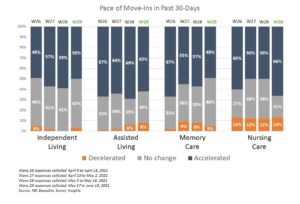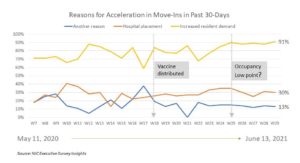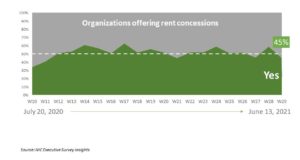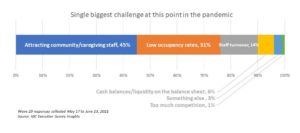“Recent data from NIC’s Executive Survey Insights, NIC MAP® Data, powered by NIC MAP Vision, and NIC Analytics suggest that cautious optimism may be justified as occupancy rates appear to have reached their low points around the end of March and are gradually improving for many operators of seniors housing and care properties across the nation. Between 48% and 71% of organizations reported upward changes in occupancy depending on the type of care segment. Of note, more than a third of organizations with assisted living residences and nearly one-half with nursing care beds saw occupancy increases of three percentage points or more. Amidst this good news, seniors housing and care occupancy rates remain at historic lows, and the number one challenge currently facing operators is attracting community/caregiving staff. ”
–Lana Peck, Senior Principal, NIC
NIC’s Executive Survey of operators in seniors housing and skilled nursing is designed to deliver transparency into market fundamentals in the seniors housing and care space as market conditions continue to change. This Wave 29 survey includes responses collected May 17 to June 13, 2021 from owners and executives of 75 small, medium, and large seniors housing and skilled nursing operators from across the nation, representing hundreds of buildings and thousands of units across respondents’ portfolios of properties.
Detailed reports for each “wave” of the survey and a PDF of the report charts can be found on the NIC COVID-19 Resource Center webpage under Executive Survey Insights.
Wave 29 Summary of Insights and Findings
- Nine out of ten organizations report an increase in lead volume since the beginning of the year (91%), and one-third are seeing lead volume currently above pre-pandemic levels (34%). A clear trend in the rising pace of move-ins began around the Wave 25 survey conducted at the end of March (however, this trend occurred sooner for the nursing care segment).
- Between two-thirds and one-half of respondents note that the pace of move-ins accelerated in the past 30-days. The shares of organizations reporting acceleration in the pace of move-ins were highest for the nursing care (66%) and assisted living care segments (62%) and the lowest for the memory care segment (49%). The nursing care segment saw the largest share of organizations reporting acceleration in move-ins (66%) since the beginning of the survey in March 2020.

- Increased resident demand has been cited by nine out of ten respondents as a reason for acceleration in move-ins since the Wave 25 survey (around the time occupancy rates may have reached bottom). Since then, the average rates of resident and staff vaccinations have leveled off at around nine out of ten residents and two out of three staff.

- The Wave 29 survey data continued to show improving trends in the percentages of organizations reporting higher occupancy rates, and each of the care segments (except independent living) set new peaks in the time series. Between 48% and 71% of organizations reported upward changes in occupancy depending on the type of care segment.

- However, the degrees of occupancy change vary. As referenced in the section above, occupancy increases in organizations with assisted living, memory care and/or nursing care beds peaked in the Wave 29 survey. However, as shown in the chart below, occupancy increases were relatively small (between 0.1 and 3 percentage points) for the independent living and memory care segments. Of note, more than a third of organizations with assisted living residences (36%) and nearly one-half (47%) with nursing care beds saw occupancy increases of three percentage points or more.

- While rent concessions may be helping to bolster occupancy rates, they are by no means the primary reason for occupancy rate increases as the percentages of organizations offering rent concessions has not increased significantly since last summer (2020) when we began tracking the data. In Wave 29, under half (45%) of respondent organizations were offering rent concessions to attract new residents. As in the prior three waves of the survey, most were discounting monthly rents (78%), and more than half (56%) were offering free rent for a specified period.

- Since the Wave 27 survey conducted in the latter half of April, the share of organizations experiencing staffing shortages in their properties has leveled off around 90%, and roughly two-thirds of organizations (64%) with multiple properties have had staffing shortages in more than one-half of their properties.

- Since the Wave 27 and 28 surveys, to attract staff, most respondent organizations are increasing wages, offering referral bonuses, and offering hiring/sign-on bonuses. Staff wages and benefits are typically the most significant operating expenses for seniors housing and care providers. As a result, and coupled with months of receding occupancy rates that had fallen to historic lows in the first quarter of 2021, NOI has been squeezed by the efforts to replace workers who left the labor force during the pandemic.
- The single biggest challenge operators are facing at this point in the pandemic are attracting community/caregiving staff (45%), followed by low occupancy rates (31%), and staff turnover (14%). The Wave 30 survey will seek to provide greater insight into the tactics operators are finding are the most effective methods of attracting new community staff today.

Wave 29 Survey Demographics
- Responses were collected between May 17 to June 13, 2021 from owners and executives of 75 seniors housing and skilled nursing operators from across the nation. Owner/operators with 1 to 10 properties comprise 64% of the sample. Operators with 11 to 25 and 26 properties or more make up 36% of the sample (21% and 15%, respectively).
- One-half of respondents are exclusively for-profit providers (50%), and 50% operate both not-for-profit (42%) and for-profit (8%) seniors housing and care organizations.
- Many respondents in the sample report operating combinations of property types. Across their entire portfolios of properties, 63% of the organizations operate seniors housing properties (IL, AL, MC), 24% operate nursing care properties, and 41% operate CCRCs (aka Life Plan Communities).
Owners and C-suite executives of seniors housing and care properties, please help us tell an accurate story about our industry’s performance.
The current survey is available and takes 5 minutes to complete. If you are an owner or C-suite executive of seniors housing and care and have not received an email invitation to take the survey, please click this link, which will take you there.
NIC wishes to thank survey respondents for their valuable input and continuing support for this effort to bring clarity and create a comprehensive and honest narrative in the seniors housing and care space at a time when trends are continuing to change in our sector.
About Lana Peck
Lana Peck, former senior principal at the National Investment Center for Seniors Housing & Care (NIC), is a seniors housing market intelligence research professional with expertise in voice of customer analytics, product pricing and development, market segmentation, and market feasibility studies including demand analyses of greenfield developments, expansions, repositionings, and acquisition projects across the nation. Prior to joining NIC, Lana worked as director of research responsible for designing and executing seniors housing research for both for-profit and nonprofit communities, systems and national senior living trade organizations. Lana’s prior experience also includes more than a decade as senior market research analyst with one of the largest senior living owner-operators in the country. She holds a Master of Science, Business Management, a Master of Family and Consumer Sciences, Gerontology, and a professional certificate in Real Estate Finance and Development from Massachusetts Institute of Technology (MIT).
Connect with Lana Peck
Read More by Lana Peck